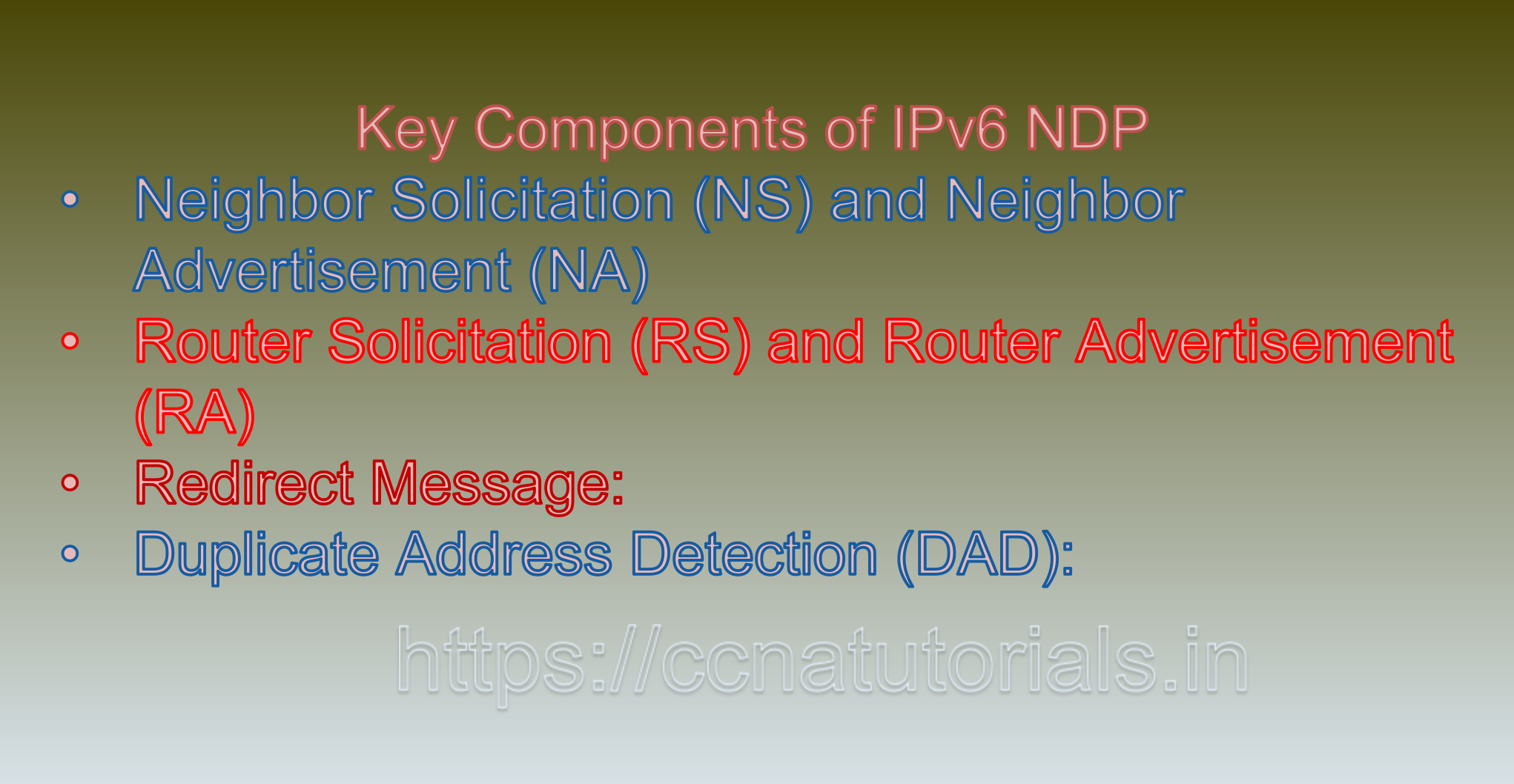Contents of this article
In this article, I describe IPv6 Neighbor Discovery Protocol (NDP): Bridging Connections in the Next-Generation Internet. In the realm of networking, the IPv6 Neighbor Discovery Protocol (NDP) stands as a cornerstone of communication, enabling devices to interact, identify, and establish connections within IPv6 networks. As the successor to ARP (Address Resolution Protocol) in IPv4, NDP plays a pivotal role in facilitating efficient address resolution, neighbor interaction, and network management. In this comprehensive exploration, we delve into the intricacies of the IPv6 Neighbor Discovery Protocol, shedding light on its key components, functions, and significance in the ever-evolving landscape of modern networking.
Understanding IPv6 Neighbor Discovery Protocol (NDP)’s Role:
IPv6 NDP serves as a vital mechanism for devices to discover and communicate with neighboring devices on the same link or subnet. It addresses various aspects of neighbor interaction, including address resolution, router discovery, parameter determination, and redirection. NDP operates at the link layer, making it an integral part of the IPv6 protocol suite and a critical component for seamless data transmission.
Key Components of IPv6 NDP:
NDP encompasses several key components that collectively enable efficient neighbor interaction and communication. Let’s explore these components in detail:
1. Neighbor Solicitation (NS) and Neighbor Advertisement (NA):
– Neighbor Solicitation is used by an IPv6 device to query the link-layer address of a neighbor or to verify its reachability.
– Neighbor Advertisement is the response to a Neighbor Solicitation and provides the link-layer address of the neighbor. It can also be used for router advertisement.
2. Router Solicitation (RS) and Router Advertisement (RA):
– Router Solicitation is sent by an IPv6 host to request router configuration information or to identify the presence of routers on the network.
– Router Advertisement is sent by routers to announce their presence and provide configuration details, including prefixes and other parameters.
3. Redirect Message:
– Redirect messages inform devices about better first-hop routers and optimize the path selection for communication.
4. Duplicate Address Detection (DAD):
– DAD ensures that the IPv6 address assigned to a device is unique within the network, preventing address conflicts.
Neighbor Discovery Protocol Functions:
1. Address Resolution:
NDP replaces ARP in IPv6 for address resolution. When a device wants to communicate with another device using its IPv6 address, it sends a Neighbor Solicitation message to resolve the corresponding link-layer (MAC) address.
2. Router Discovery:
NDP facilitates the automatic discovery of routers on a link. Routers periodically send Router Advertisement messages to provide essential network information to hosts, including prefixes, default gateway information, and hop limits.
3. Address Autoconfiguration:
NDP enables hosts to configure their own IPv6 addresses automatically. When a host connects to a network, it uses Router Advertisement messages to determine network prefixes and generate unique IPv6 addresses.
4. Neighbor Reachability Detection:
NDP helps devices monitor the reachability of neighboring devices. Neighbor Advertisement messages confirm the continued presence and activity of neighboring devices.
5. Path MTU Discovery:
NDP assists in determining the Maximum Transmission Unit (MTU) size of the network path, preventing fragmentation and optimizing data transmission.
Significance in Modern Networking:
IPv6 NDP plays a crucial role in shaping modern networking practices and addressing the challenges of the digital age:
1. Efficient Address Resolution:
NDP streamlines address resolution processes, reducing broadcast traffic and enhancing network efficiency compared to ARP in IPv4.
2. Network Stability:
By facilitating reachability detection and redirect messages, NDP ensures reliable communication paths and minimizes disruptions due to changes in network topology.
3. Automatic Configuration:
NDP’s autoconfiguration capabilities simplify the process of assigning and managing IPv6 addresses, reducing the need for manual configuration.
4. Security and Redirection:
The redirection function of NDP helps optimize traffic flow and enhance network security by directing devices to better first-hop routers.
5. Smooth Migration:
As organizations transition from IPv4 to IPv6, NDP’s familiarity and compatibility with IPv4 networks ease the migration process and facilitate coexistence.
Real-World Example of IPv6 Neighbor Discovery Protocol (NDP):
Consider a scenario where a user’s laptop joins a new Wi-Fi network. Through IPv6 NDP, the laptop automatically configures its IPv6 address using Router Advertisement messages. It also resolves the link-layer address (MAC address) of the router using Neighbor Solicitation and Advertisement messages. This allows the laptop to efficiently communicate with devices on the local network and access external resources through the router.
Challenges and Security Considerations:
While NDP offers significant benefits, it also presents potential security challenges, including Neighbor Spoofing and Neighbor Cache Poisoning attacks. Network administrators must implement security measures, such as IPv6 address filtering and NDP snooping, to mitigate these risks.
IPv6 Neighbor Discovery Protocol (NDP) summary:
The IPv6 Neighbor Discovery Protocol (NDP) serves as the linchpin of neighbor interaction and efficient communication within IPv6 networks. Its multifaceted functions, from address resolution to router discovery, contribute to streamlined networking, automatic configuration, and enhanced network stability. As the digital landscape continues to evolve, NDP remains an essential component, bridging the gap between devices and enabling the seamless flow of data in the next-generation Internet. A comprehensive understanding of NDP is indispensable for network professionals as they navigate the complexities and opportunities of modern networking environments.

IPv6 Neighbor Discovery Protocol (NDP): Building Connections and Enabling Communication explained in another terms
In the realm of IPv6 networking, the Neighbor Discovery Protocol (NDP) stands as a crucial mechanism that fosters efficient communication and facilitates the seamless operation of devices within a network. Serving as a successor to the Address Resolution Protocol (ARP) in IPv4, NDP plays a pivotal role in addressing and routing by enabling devices to discover and interact with neighboring devices. Let’s dive into the intricacies of NDP through real-world examples to better understand its functions, significance, and practical applications.
Neighbor Discovery Protocol: Unveiling the Basics:
NDP is a fundamental component of the IPv6 protocol suite, operating at the link layer. It serves as a tool for devices to discover and manage the presence of other devices within the same subnet or link. NDP encompasses various functionalities, including address resolution, router discovery, neighbor reachability detection, and more. By facilitating these functions, NDP ensures efficient data transmission and network management.
Example 1: Address Resolution (Neighbor Solicitation and Advertisement):
In IPv6, as in IPv4, devices need to map IPv6 addresses to corresponding link-layer (MAC) addresses for effective communication. NDP achieves this through Neighbor Solicitation (NS) and Neighbor Advertisement (NA) messages.
Suppose Device A (IPv6 address: 2001:db8::A) wishes to communicate with Device B (IPv6 address: 2001:db8::B). To do so, Device A sends a Neighbor Solicitation message to inquire about Device B’s MAC address:
Device A Device B
——————— ———————
| IPv6: 2001:db8::A | ——> | IPv6: 2001:db8::B |
| MAC: AA:AA:AA:AA | | MAC: BB:BB:BB:BB |
——————— ———————
Neighbor Solicitation (NS):
– Source: 2001:db8::A
– Destination: 2001:db8::B
– Target: 2001:db8::B
Device B, upon receiving the NS message, responds with a Neighbor Advertisement message containing its MAC address:
Device A Device B
——————— ———————
| IPv6: 2001:db8::A | <—— | IPv6: 2001:db8::B |
| MAC: AA:AA:AA:AA | | MAC: BB:BB:BB:BB |
——————— ———————
Neighbor Advertisement (NA):
– Source: 2001:db8::B
– Destination: 2001:db8::A
– Target: 2001:db8::B
The NS and NA messages allow Device A to successfully map Device B’s IPv6 address to its MAC address, enabling effective communication.
Example 2: Router Discovery (Router Solicitation and Advertisement):
NDP plays a pivotal role in discovering routers within a network, allowing devices to learn about available routers and their configuration.
When a new device joins a network, it may not be aware of the presence of routers. In this scenario, the device sends a Router Solicitation (RS) message to inquire about routers on the network:
New Device Routers
——————— ———————
| IPv6: 2001:db8::C | ——> | IPv6: 2001:db8::R |
| MAC: CC:CC:CC:CC | | MAC: RR:RR:RR:RR |
——————— ———————
Router Solicitation (RS):
– Source: 2001:db8::C
– Destination: All Routers
Routers respond with Router Advertisement (RA) messages, providing essential configuration details to the new device, such as network prefixes and default gateway information:
New Device Routers
——————— ———————
| IPv6: 2001:db8::C | <—— | IPv6: 2001:db8::R |
| MAC: CC:CC:CC:CC | | MAC: RR:RR:RR:RR |
——————— ———————
Router Advertisement (RA):
– Source: 2001:db8::R
– Destination: 2001:db8::C
– Prefix Information: 2001:db8::/64
– Default Gateway: 2001:db8::R
As a result, the new device learns about available routers and gains essential network configuration information, enabling it to communicate effectively with other devices and access external resources.
Example 3: Neighbor Reachability Detection:
NDP’s Neighbor Reachability Detection ensures that neighboring devices remain reachable and active. It involves periodic exchange of Neighbor Solicitation and Advertisement messages to verify the continued presence of neighbors.
Imagine Device X (IPv6 address: 2001:db8::X) wants to ensure that Device Y (IPv6 address: 2001:db8::Y) remains reachable:
Device X Device Y
——————— ———————
| IPv6: 2001:db8::X | ——> | IPv6: 2001:db8::Y |
| MAC: XX:XX:XX:XX | | MAC: YY:YY:YY:YY |
——————— ———————
Periodic Neighbor Solicitation and Advertisement messages confirm the reachability of Device Y.
Conclusion for IPv6 Neighbor Discovery Protocol (NDP):
IPv6 Neighbor Discovery Protocol (NDP) plays an instrumental role in modern networking by enabling devices to seamlessly interact and communicate within a network. Through practical examples, we’ve witnessed how NDP facilitates address resolution, router discovery, neighbor reachability detection, and more, ultimately contributing to efficient data transmission, network stability, and optimal resource utilization. As networking technologies continue to evolve, NDP remains a foundational mechanism, bridging connections and fostering efficient communication in the ever-expanding digital landscape.






